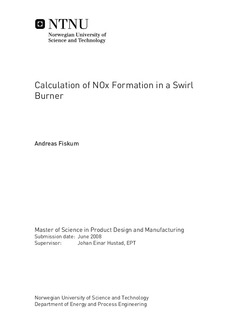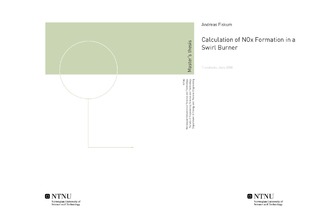| dc.contributor.advisor | Hustad, Johan Einar | nb_NO |
| dc.contributor.author | Fiskum, Andreas | nb_NO |
| dc.date.accessioned | 2014-12-19T11:46:15Z | |
| dc.date.available | 2014-12-19T11:46:15Z | |
| dc.date.created | 2011-06-27 | nb_NO |
| dc.date.issued | 2008 | nb_NO |
| dc.identifier | 426908 | nb_NO |
| dc.identifier | ntnudaim:4300 | nb_NO |
| dc.identifier.uri | http://hdl.handle.net/11250/234208 | |
| dc.description.abstract | This thesis embraces simulations of NOx emissions from a partially premixed 20 kW swirl burner. The simulations were carried out in the commercial computational fluid dynamics software FLUENT. The concept of partial premixing air and fuel before adding additional air for complete combustion has proven promising with a view on the NOx emissions. However, little research has been done on reach premixing of fuel and air and therefore further investigation of this topic is of interest. In most experiments in the literature methane is used as fuel, but due to problems with stability and blow off in the 20 kW swirl burner propane were chosen as fuel.Simulations of eight different air-fuel ratios have been performed, ranging from diffusion flame to a mass based air-fuel ratio of four. The results from these simulations proved satisfactory when comparing with previous experimental and simulated work, except from the calculations of the exact NOx concentration. This difference in the concentration was one the other hand expected since the power of FLUENT and similar software is to predict variation trends and not the exact value itself.The simulations showed that the NOx concentration increased with increasing premixing, reaching a local peak at an air-fuel ratio of two. After this a local minimum in the NOx concentration was observed before a strong increase when further raising the air-fuel ratio. This is the same trends that are observed in the literature when using methane as fuel, but for propane there is no global reduction in the NOx emissions when applying premixing. This increase in the NOx emission was found to be due to an expansion of the high temperature flame zone with increasing premixing, which benefits the thermal NOx formation mechanism. The NOx reducing effect of swirl generation observed to decrease when the air-fuel ratio was increased. For subsequent experimental work it is recommended to perform a high amount of experiments at different air-fuel ratios, especially in the ratio range where the NOx concentrations starts to fluctuate. | nb_NO |
| dc.language | eng | nb_NO |
| dc.publisher | Institutt for energi- og prosessteknikk | nb_NO |
| dc.subject | ntnudaim:4300 | no_NO |
| dc.subject | MTPROD produktutvikling og produksjon | no_NO |
| dc.subject | Energi-, prosess- og strømningsteknikk | no_NO |
| dc.title | Calculation of NOx Formation in a Swirl Burner | nb_NO |
| dc.type | Master thesis | nb_NO |
| dc.source.pagenumber | 78 | nb_NO |
| dc.contributor.department | Norges teknisk-naturvitenskapelige universitet, Fakultet for ingeniørvitenskap og teknologi, Institutt for energi- og prosessteknikk | nb_NO |

